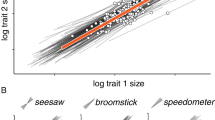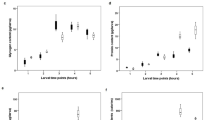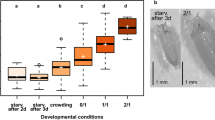Abstract
BEGINNING in 1946 a population of Tenebrio molitor (Coleoptera, Tenebrionidae) was reared continuously in standard optimal or sub-optimal conditions of food, temperature and humidity, avoiding as much as possible interferences of cannibalism and overpopulation. At the same time, artificial selection in favour of small and big pupal weights was undertaken and resulted in splitting the initial population into two strains, one labelled F (small weights), the other labelled G (big weights). The first eight years were mainly devoted to this work of selection, consisting in the removal of all F-pupæ weighing more than 160 mg, then more than 130 mg, and of all G-pupæ weighing less than 160 mg. From 1952 on, after about 12 consecutive generations of both strains, both appeared definitely homogeneous and no further selection was needed save in quite exceptional instances1. It had also become obvious that by selecting for weights one had also selected automatically in favour of shorter or longer durations of larval development. Further attempts to split the two strains in order to obtain dwarf strains failed2. Thus time had come to find out whether the two strains differed also in other respects. They do so indeed, to an extent that it is now possible to formulate a true physiological diagnosis involving quite a number of unexpected characters.
This is a preview of subscription content, access via your institution
Access options
Subscribe to this journal
Receive 51 print issues and online access
$199.00 per year
only $3.90 per issue
Buy this article
- Purchase on Springer Link
- Instant access to full article PDF
Prices may be subject to local taxes which are calculated during checkout
Similar content being viewed by others
References
Leclercq, J., Physiol. Compar. et Oecol., 2, 161 (1950); 4, 89 (1955).
Leclercq, J., Bull. Soc. Roy. Sci. Liège, 24, 52, 60 (1955).
Huot, L., and Leclercq, J., Arch. Intern. Physiol. Biochem., 66, 270 (1958).
Leclercq, J., Bull. Soc. Roy. Sci. Liège, 25, 296, 317 (1956).
Huot, L., Leclercq, J., and Florkin, M., Arch. Intern. Physiol. Biochem., 67, 461 (1959).
Leclercq, J., Bull. Soc. Roy. Sci. Liège, 25, 336 (1956).
Fraenkel, G., and Leclercq, J., Arch. Intern. Physiol. Biochem., 64, 601 (1956).
Leclercq, J., Arch. Intern. Physiol. Biochem., 68, 500 (1960).
Moreau, C., and Leclercq, J., Bull. Soc. Roy. Sci. Liège, 32, 157 (1963).
Collinet, C., Bull. Soc. Roy. Sci. Liè, 26, 381 (1957).
Author information
Authors and Affiliations
Rights and permissions
About this article
Cite this article
LECLERCQ, J. Artificial Selection for Weight and its Consequences in Tenebrio molitor L.. Nature 198, 106–107 (1963). https://doi.org/10.1038/198106b0
Issue Date:
DOI: https://doi.org/10.1038/198106b0
This article is cited by
-
Mating compatibility and offspring traits evaluation among different strains of Tenebrio molitor
Environmental Science and Pollution Research (2023)
Comments
By submitting a comment you agree to abide by our Terms and Community Guidelines. If you find something abusive or that does not comply with our terms or guidelines please flag it as inappropriate.



